In the fast-paced digital landscape, the need for efficient file management on our Android devices has become more critical than ever. Whether it's freeing up space on your smartphone or safeguarding essential documents, the ability to seamlessly transfer files from Android to a USB flash drive is a valuable skill. This article aims to guide you through 6 secure and tested methods, providing step-by-step instructions on the options available. Whether your Android device supports USB On-The-Go (OTG) or you're exploring alternatives, we'll help you navigate the process with ease.
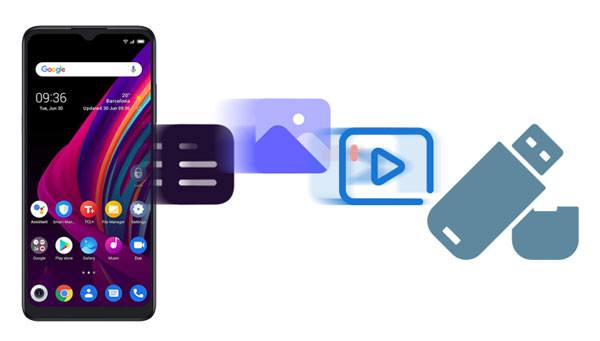
Why do people want to transfer files from Android to thumb drives? Here are the importance and necessity:
1. Backup and Storage
USB flash drives provide additional storage space for your files. Transferring important documents, photos, videos, and other data to a flash drive ensures that you have a backup in case your Android device is lost, damaged, or needs a factory reset.
2. File Sharing and Collaboration
If you need to share files with others or collaborate on a project, transferring files to a USB flash drive allows you to easily share the data without relying on internet connectivity or cloud storage.
3. Security and Privacy
Storing sensitive or private files on a USB flash drive rather than on your Android device can enhance security and privacy. It provides physical control over the storage medium and reduces the risk of unauthorized access.
4. Offline Access
USB flash drives allow you to carry your files with you and access them offline. This is useful in situations where you may not have internet access or want to avoid using mobile data.
5. Freeing Up Storage
If your Android device is running low on storage space, transferring files to a USB flash drive can help free up internal storage, potentially improving the device's performance.
Some USB flash drives can be connected to a computer but not a mobile phone, so it is inconvenient to import your Android files to the drive. Nevertheless, you can ask an OTG adapter for help. This gadget can help you plug your USB stick into your phone for connection. Once connected, you can access the drive on your mobile device, and move the files you want from Android to the flash drive.
Step 1: Plug the micro-USB or USB-C end of the OTG cable into your Android device. Then connect the USB flash drive to the standard USB port on the OTG cable.
Step 2: Your Android device may prompt you to grant permissions to the connected USB device. Allow the necessary permissions.
Step 3: Open the File Manager app on your Android device. Navigate to the files you want to transfer. Long-press on the file or folder you want to transfer. A menu should appear. Select "Copy" or "Move", depending on whether you want to keep a copy on your device or move it entirely.
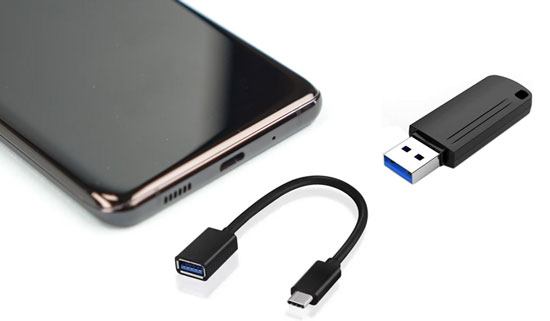
Bonus: Searching for a tool to move data from Android to an iOS device? You can check this list.
What if you prefer to transfer files from Android to a USB flash drive without OTG rather than using OTG? If so, you can utilize 5 solutions in this section to make it.
It's easy to move files from an Android device to USB storage with the help of this Android file manager - Samsung Messages Backup. This software can scan and display diverse Android files by category, allowing you to view, select and transfer your files to your computer or a connected USB flash drive. What's more, all your media files, like videos, photos, audio files, etc., will be saved with the original quality and format.
Plus, you can copy your contacts, SMS, and call logs to your USB stick for backup. These data is inconvenient to transfer on your Android device, but now, you can move them directly.
- Transfer almost all kinds of data from an Android phone or tablet to a computer or an external USB stick, such as contacts, text messages, photos, videos, music, etc.
- Move your files without compromising their quality.
- Support USB and Wi-Fi transfers.
- Allow you to manage your contacts and other files on your computer with multiple functions, like editing, deleting, exporting, and more.
- Enable you to receive and send SMS on your computer, so you won't miss your important messages.
- Directly take screenshots of your Android mobile device and save them to your computer.
- Compatible with most Android devices running Android OS 4.0 and upper, and no restrictions on phone brands.
- 1-year license: $29.95
- Lifetime license: $39.95
- Business license: $39.95
Note: It is free to scan and preview your Android data on a computer.
Download this software below.
Use this program to effortlessly transfer videos and other files from Android to the flash drive:
Step 1: After downloading its package, please double-click it to install the program on your computer. Then launch it and choose the "Android Assistant" tab.
Step 2: Establish the connection between your Android phone and your computer, and plug the USB drive into the computer. If prompted, please allow the USB debugging on Android. Then the software will fast recognize your device.
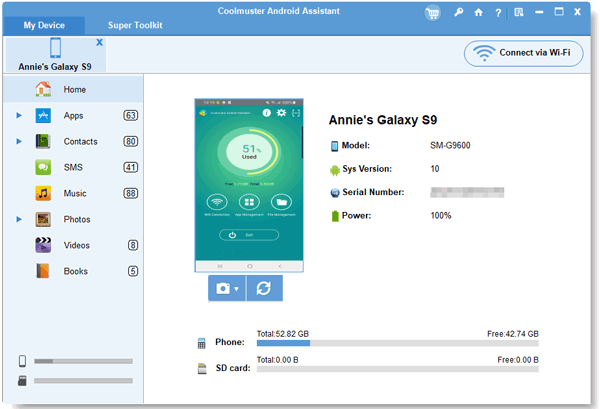
Step 3: Choose a category from the left panel, and select the files you want to move. Then click the "Export" icon, and select your USB flash drive as the destination. The software will copy the files to the thumb drive.
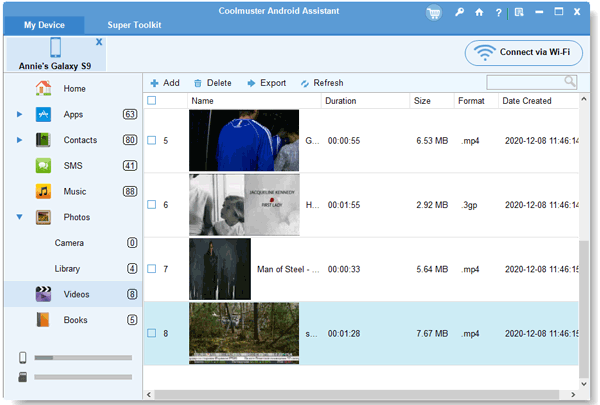
Tips: How to back up Android data to a flash drive in 1 click? There is a backup feature that you can find by clicking the "Super Toolkit" icon. Then click the "Backup" option, and pick the data types you want. Next, tap the "Browse" icon to select your USB drive, and click the "Back Up" button. The backup process will start.
If your USB stick has a Type-C port, you can directly insert it into your Android phone to make a connection. But please check if your phone port is Type-C in advance. By the way, there are kinds of USB sticks on the market; please pay more attention to their port types, transferring speed, etc.
Step 1: Plug your USB stick into your Android phone, and your phone will detect it quickly.
Step 2: Open File Manager, and copy those files you want.
Step 3: Go to the USB drive, and paste your files to it. After that, you will complete the transfer.
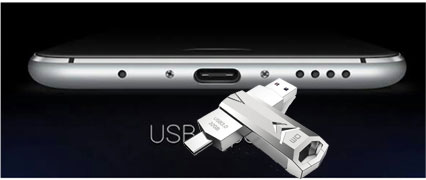
Learn more: You can also easily copy the files from your SD card to a PC in these 5 ways. Let's take a look.
If the pre-installed file manager is damaged, you can use Files by Google to transfer videos, photos, and more files from your Android phone to a flash drive. This app can organize your files by category.
Step 1: Install Files by Google on your Android smartphone, and open it.
Step 2: Link your flash drive to your Android smartphone, and go to the app to choose "Browse" at the bottom. Then click "Storage devices" to tap your phone storage.
Step 3: Locate the files you desire to transfer, and click the down-arrow icon to select "Move to". Now choose a location that you want to move your files to, and hit "Move here".
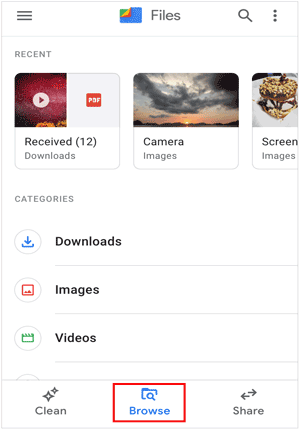
To transfer files from a phone to a USB drive, you can use your computer as a transit point. In this way, what you need is a USB cable for your Android device, and you can start the transfer.
Step 1: Plug your USB flash drive into your computer, and connect your Android device to the computer via a data cable.
Step 2: Choose the "Transfer files" or "MPT" option on Android, and access your USB drive on the computer desktop.
Step 3: Open your Android folder on the computer, and drag and drop your desired files from your Android phone to the USB stick. Please patiently wait for the transmission.
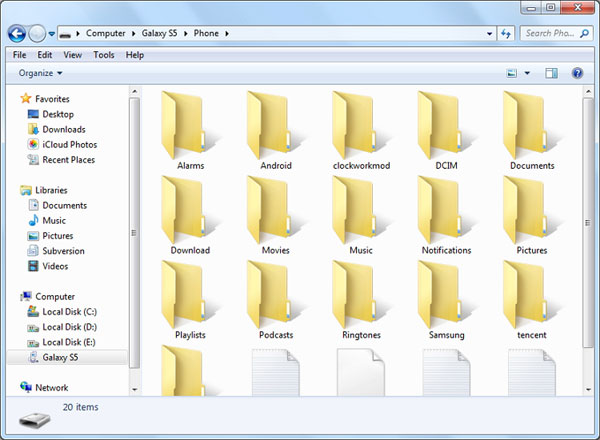
See also: With this guide, you can seamlessly transfer photos from an Android phone to a USB flash drive.
If your flash drive doesn't support a Type-C port, and you want a wireless transfer tool, Send Anywhere will help. This app is suitable for wireless file transmission between devices. Thus, you still need to use a computer as a medium when you plan to share files from Android to a thumb drive.
Step 1: Install the app on your phone, launch it and grant the permissions.
Step 2: Pick the files you want to send, and click the "Send" icon. Then open the "https://send-anywhere.com/" web on your computer.
Step 3: Input the key to the "Receive" blank, and then you will receive the files on your computer.
Step 4: Connect your flash drive to the computer, and move the files you received just now to the removable drive.
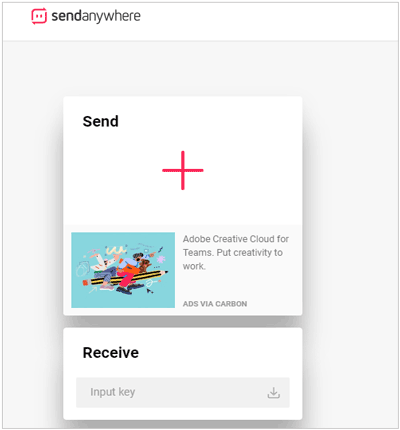
Q1: How do I check if my Android phone supports USB On-The-Go (OTG)?
Check your phone's specifications or user manual for OTG support. You can also try connecting a USB device using an OTG cable or adapter to see if your phone recognizes it.
Q2: What file formats are compatible with USB flash drives for Android?
USB flash drives typically support common file formats like FAT32 and exFAT. Ensure your files are in compatible formats to avoid issues during transfer.
Q3: Can I use a USB hub to connect multiple USB devices to my Android phone for file transfer?
Yes, if your Android device supports USB OTG and the hub is compatible. Connect the USB hub to your phone, and then connect multiple USB devices, including a USB flash drive.
Q4: What security considerations should I keep in mind during file transfers?
Be cautious about sensitive data. Use secure connections, consider encryption for confidential files, and be aware of app permissions when using file transfer apps.
The versatility of file transfer methods from Android to USB flash drives empowers you to manage your data efficiently. From the indispensable role of USB OTG to the versatility of wireless alternatives and manual transfers, each method offers a unique solution to the common challenge of managing data effectively.
If you want to transfer more file types and manage your Android files handily on your computer, you can select the file management software - Samsung Messages Backup. With it, you can transfer those files that you cannot view on your Android internal folders. Try it if you want.
Related Articles
How to Transfer Contacts from iPad to Android Smoothly | 6 Wise Methods
Control Android from PC Conveniently | 7 Powerful Tools
How to Find Android Recycle Bin and Recover Deleted Files Easily
6 Ways to Transfer Files from Android to PC via WiFi [New Guide]
How to Transfer Photos from Mac to Android in 5 Expeditious Ways
Effortlessly Transfer SIM Card Data to Computer without Data Loss
Copyright © samsung-messages-backup.com All Rights Reserved.